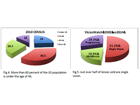In the final Part Four of this series about utilizing newer lens designs and technologies to provide better vision for our single vision. Coming back to our original assertion in Part One—It's time to consider changing the way we think of single vision and begin shifting even the basic SV order to one that includes more technology. That means the regular use of aspheric, atoric (Dual aspheric) and Free-form surfaces.
Prescription and Other Lens Size
We so often just check the single vision lens box on the order form and pay little attention to the lens' design. The lab will most often choose a finished toric lens, out of the envelope. So, which lenses should be different for which wearers?
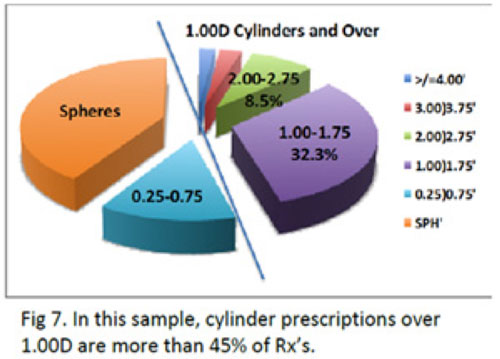
From an Rx perspective (in my view) double aspheric and Free-form lenses, in high lens powers (greater than -2.00D and +1.50D) and, prescriptions with cylinders of 1.00D or greater will deliver improved vision success. Moreover, as the lens size gets bigger (think large retro style frame) or as the decentration increases, more of a lens' periphery is visible to the wearer. As a result, better treatment of vision in the periphery leads to patients saying, "I see better." As I've said before, the larger the clear field of view, typically, the happier the patient.
In an analysis of about 29 thousand single vision lab prescriptions, almost 45 percent of the prescriptions were beyond -2.00D and +1.50. More importantly, an analysis of the cylinder prescriptions shows that about 46 percent had cylinders of 1.00D and above.
Therefore, consideration of lens surface design, to deliver better vision, should be important to about half of all the single vision lens patients seen. What can you do about that? Consider replacing ordinary single vision lenses with aspheric, double aspheric and Free-form single vision lenses.
To be effective for the variety of patients that come through an optical office, the double aspheric lenses prescription range must be very wide. The Seiko MV Double Aspheric lens range in 1.67 is available in -10.00D to +6.00D sphere to a -5.00D cylinder. From the analysis done, cyls over 4.00D accounted for 2 percent of the Rx's processed.
Ideal for higher Rx's and high cylinders is the 1.74 index Seiko Super MV AR, which further improves the cosmetics of higher powered prescriptions. In a range of +10.00D to -20.00D to a -5.00D cylinder (total power -20.00D), these lenses also deliver double asphericity.
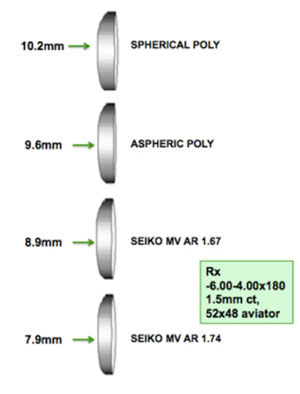
While double aspherics can be lab ordered at any time, finished lenses provide fast turnaround. For in-office finishing practices, a stock lens series in 1.6 high index, double aspheric (Seiko DA) is available for the myope with prescriptions from plano to -10.00D, cylinders to -2.00D.
Better Looking
Of course, aside from the larger field of view aspheric and double aspheric lenses look better too. Fig 8 illustrates the improved thinness of lenses as the front base curve design is flattened (plus lenses) or steepened in the periphery (minus lenses) and index is increased. More than a 20 percent reduction in edge thinness is possible.
Double-aspheric Free-form design lenses are thinner & lighter with flatter curves on both sides. The back surface Free-form compensation virtually eliminates power error, distortion and marginal astigmatism. In addition magnification is reduced for hyperopes, making more of the field available within the opening of the eyeglass eyewire.
This significantly improves peripheral vision clarity and size of field, making them ideal for difficult Rx's, especially high cylinder. In Fig 9. I edged two +5.25 – 1.75 x 170 lenses, one in hard resin from the stock lens drawer (70mm diameter), the other surfaced to the PD, frame size and shape. Of course this isn't an apples to apples comparison but does show the extreme benefit of doing this prescription using the lens with applied double asphericity for a better visible result.
In addition, all 1.67 and 1.74 lenses include a super hydro- and oleophobic AR for easy cleaning, further enhancing the lenses overall clarity.
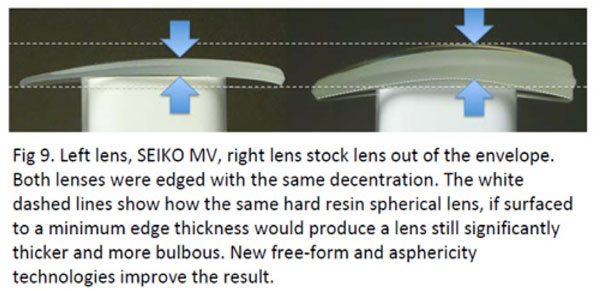
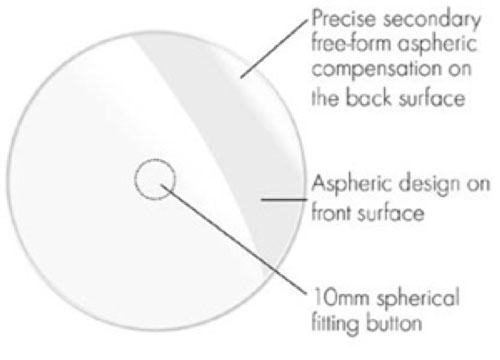
Free-form and double aspheric lenses are best fit considering lens tilt. As a result, request spectacle orders with the optical center or point of prescribed prism placed 4mm below pupil center. This assumes the frame has about 8-9 degrees pantoscopic tilt. Some teach fitting aspheric lenses with the optical center at pupil center. This is incorrect since lens performance is reduced when not considering tilt. For even more precision in peripheral lens design using Free-form, specify the lens tilt measurement when ordering.
In addition, and unique to Seiko Free-form lenses is a patented spherical, 10mm 'fitting' button. This ensures a small area of uniform power for verification using all aperture lensmeters and ease of fitting.
Conclusion
A double aspheric low base curve design compensates for distortion, peripheral power error and astigmatic aberration in a balanced manner. Using Free-form technology, the result is exceptional clarity of vision throughout the entire lens, a significant improvement in the effective viewing area, and better cosmetics, especially in prescriptions with high powers and/or high cylinder. A Free-form back surface provides precise secondary aspheric/atoric compensation for each individual prescription, for exceptionally wide peripheral vision with stable, comfortable vision throughout the lens.

Mark Mattison-Shupnick, ABOM, is currently director of education for Jobson Medical Information LLC, has more than 40 years of experience as an optician, was senior staff member of SOLA International and is a frequent lecturer and trainer.



